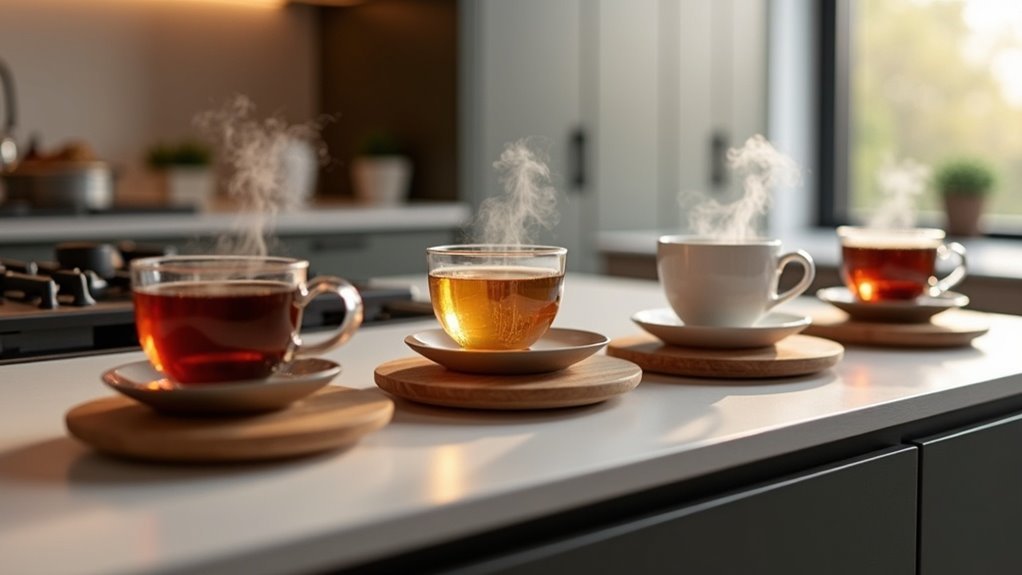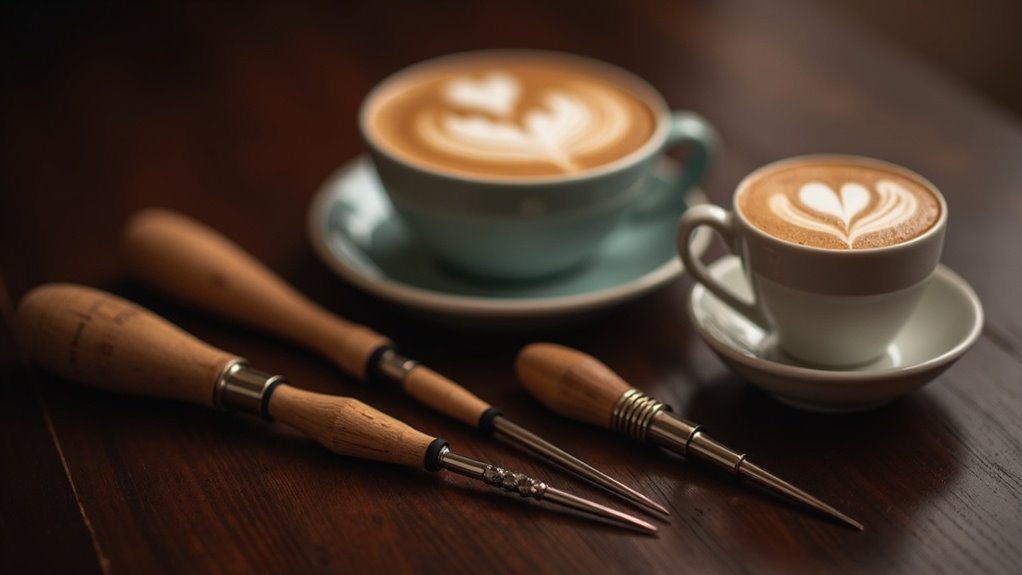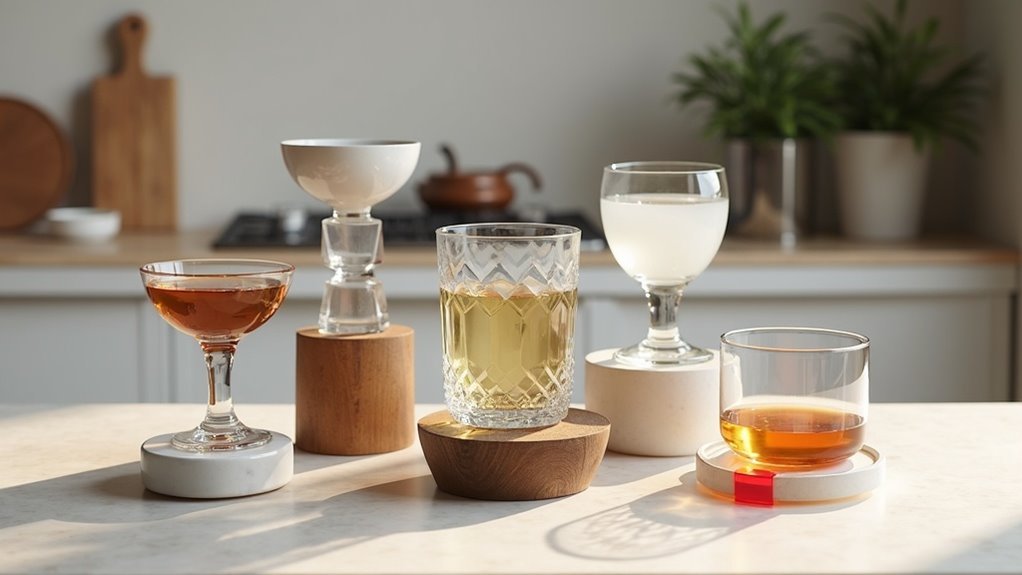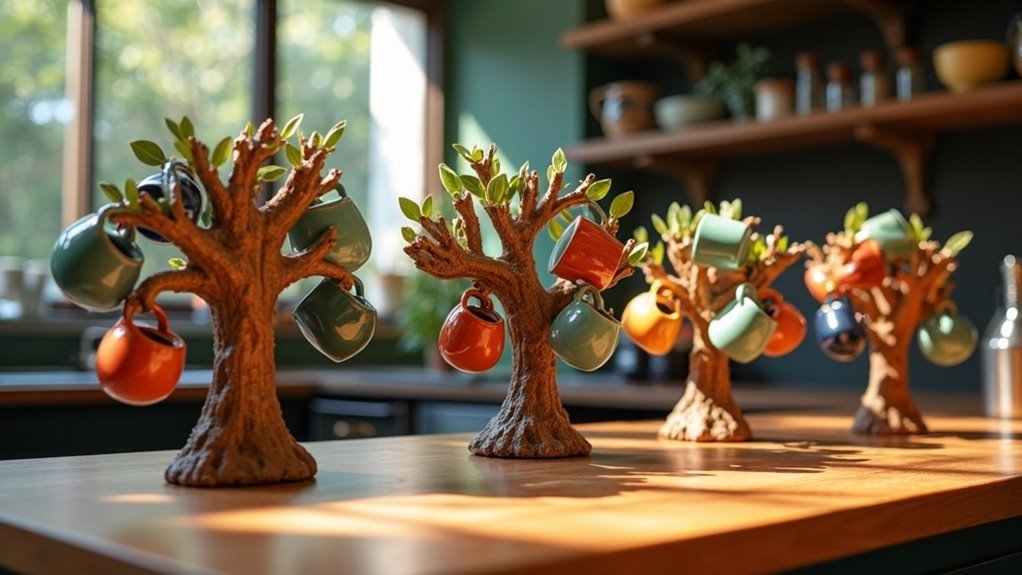South Indian Degree Coffee is a robust and flavorful beverage, celebrated for its rich history and unique brewing techniques. Made from high-quality dark-roasted arabica beans blended with chicory, it’s brewed using a traditional filter to create a strong decoction. This creamy coffee is aerated when poured between vessels, enhancing its taste and texture. It embodies the warmth of South Indian culture and social connections, inviting you to explore its ingredients and preparation methods further. Discover the art of brewing and savoring this delightful coffee experience.
Key Takeaways
- South Indian Degree Coffee, a beloved beverage, originated in the 19th century and is deeply rooted in the region’s cultural heritage, particularly within the Brahmin community.
- It is characterized by the use of high-quality dark-roasted arabica or Peaberry beans, often blended with chicory, which adds to its rich flavor profile.
- The traditional brewing method employs a South Indian filter, resulting in a strong decoction that is commonly mixed with boiled milk to create a delightful drink.
- Degree Coffee holds significant social value, symbolizing warmth, hospitality, and the nurturing of connections both in homes and coffee houses.
- In contemporary times, adaptations such as bottled decoction and instant coffee sachets have made it more convenient for enthusiasts to savor this traditional beverage.
History of South Indian Degree Coffee
South Indian Degree Coffee boasts a captivating history that traces back to the 19th century, during the expansion of British colonial rule which saw coffee cultivation flourish in the verdant hills of South India.
This distinctive beverage, closely associated with the Brahmin community, not only serves as a symbol of social status but also ignited caste struggles surrounding access to coffee.
A symbol of social status, this coffee has sparked caste struggles within the Brahmin community.
The brewing method highlights a strong decoction, complemented by thick, fresh milk, yielding a robust flavor that characterizes the drink. Traditionally served hot in a Dabara and tumbler, it results in a delightful frothy concoction.
The establishment of the Coffee Board of India in the 1940s played a significant role in standardizing and popularizing this regional gem.
Ingredients Used in Degree Coffee
At the heart of South Indian Degree Coffee lies a carefully curated selection of ingredients that contribute to its unique flavor and character.
High-quality Plantation A washed arabica or Peaberry coffee beans form the base, typically dark roasted to enhance their richness. Often, the coffee powder is blended with chicory, adding a slight bitterness that beautifully complements the brew.
The magic happens when you combine a thick decoction brewed from boiling water with hot milk, creating a rich, creamy texture. Sweeteners like white sugar, once a modern choice, perfectly balance the coffee’s boldness, making each sip an experience to savor in a traditional tumbler.
Brewing Process of Degree Coffee
Brewing Degree Coffee requires a specialized approach that highlights its rich flavors and aromas.
Start by using a traditional South Indian filter, placing the filter coffee powder in the upper chamber. Pour boiling water over the coffee to extract a strong coffee decoction, which takes about 10 to 15 minutes.
Coffee lovers often prefer the first degree decoction for its robust taste, made from finely ground arabica and chicory.
Once brewed, mix the decoction with boiled milk. To serve, aerate the coffee by pouring it back and forth between a dabarah and tumbler, ensuring you enjoy a delightful coffee experience.
Cultural Significance of Degree Coffee
Degree coffee isn’t just a beverage; it’s a vibrant part of South Indian culture that embodies warmth and hospitality. This strong coffee, served in traditional metal tumblers, fosters family bonds and social connections.
Historically linked to the upper-class Brahmins, its cultural significance continues to evolve. Rituals of preparation and measurement are cherished traditions, passed down through generations.
You’ll find degree coffee not just in homes, but also in bustling coffee houses and communal spaces, where friends and families gather. Each sip reflects a rich tapestry of Indian heritage, making it more than just a drink—it’s a shared experience that connects people over the love of coffee.
Modern Adaptations and Convenience
Today’s coffee enthusiasts are turning to local suppliers like Ministry of Kaapi, which makes authentic South Indian coffee more accessible than ever.
With bottled decoction options and traditional brewing equipment readily available, you can effortlessly recreate the cherished brewing experience in the comfort of your home.
Whether you prefer the convenience of iD coffee sachets or wish to explore different chicory ratios, savoring the perfect cup of degree coffee is now easier than you might think.
Local Supplier Discoveries
As more coffee enthusiasts seek authentic experiences from the comfort of their homes, local suppliers like Ministry of Kaapi have stepped up to bridge the gap between tradition and modern convenience in the world of coffee. These businesses offer unique blends of authentic South Indian coffee alongside traditional coffee paraphernalia, making it easier to embrace this rich coffee culture. With bottled decoction options and easy-to-use sachets, the brewing process becomes hassle-free, even for newcomers. Here’s a snapshot of what local suppliers provide:
| Product Type | Description | Convenience Level |
|---|---|---|
| Unique Blends | Specially crafted coffee flavors | High |
| Bottled Decoction | Ready-to-use coffee | Very High |
| Easy-to-Use Sachets | Instant brewing solutions | Extremely High |
| Traditional Filters | Authentic coffee preparation tools | Moderate |
| Coffee Tumblers | Perfect for serving | High |
Bottled Decoction Options
When you’re craving a taste of authentic South Indian coffee without the hassle of traditional brewing, bottled decoction options come to the rescue.
These convenient storage solutions keep your South Indian filter coffee fresh in the fridge for up to a month. Brands like iD make it easy for coffee enthusiasts to enjoy the rich, authentic flavors by offering ready-to-use coffee sachets.
Simply mix the bottled decoction with hot milk, and you’ve got a delightful coffee drink in minutes. With options like Ministry of Kaapi, you can savor a fresh coffee experience, even outside India, without the need for daily preparation.
Traditional Equipment Availability
For those enthusiastic to recreate the authentic South Indian coffee experience at home, traditional equipment like stainless steel filters, dabarahs, and tumblers are now readily available both online and in specialty stores.
You can also find coffee powder that perfectly complements these tools, including chicory blends that enhance the traditional flavor profile.
When making coffee, the stainless steel coffee filter guarantees a rich decoction, essential for that Kumbakonam degree taste.
With convenient options like iD coffee sachets, it’s easier than ever to enjoy this cultural delight.
Embrace these modern adaptations while still savoring the essence of filter coffee!
Serving Tips and Community Engagement
Serving South Indian degree coffee is an art that enhances not just the flavor but also the experience of enjoying this beloved beverage. Start by using a perfect South Indian filter to brew a strong decoction, adjusting the coffee strength to suit your taste preferences.
When serving, pour back and forth between the Dabara and tumbler, adding boiled milk and sugar for sweetness.
To foster community engagement, share your coffee memories and preparation tips with others. Post images of your coffee at home on social media, inviting fellow coffee enthusiasts to celebrate this cultural tradition together.
Additionally, consider decorating your serving methods to create a visually appealing experience that connects you with others and enriches the joy of coffee.








